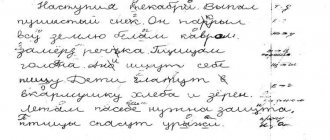Article by speech therapist-psychologist T.B. Zukor
Dysgraphia is a complex of specific disorders of writing function in humans.
How to understand that a child has dysgraphia? A simple example. Your child starts school, and over time you notice that he has difficulties with writing. Most often, this is discovered when completing tasks in the Russian language, and at the same time, the student can demonstrate success in mathematics. Many parents begin to scold their child, forcing them to rewrite the exercise several times, but do not get the desired result. If you notice that there is some consistency or specificity in your child’s mistakes, then perhaps we are talking about dysgraphia.
Possible errors with dysgraphia:
- skips letters (vowels or consonants)
- does not complete the ending of the word
- rearranges syllables in words
- skips syllables
- confuses letters that have a common element, for example, the written “b” and “d”, “i” and “sh”
- replaces letters denoting paired sounds: “b” with “p”, “t” with “d”, “z” with “s”, etc.
- writes all the words in a sentence together
- does not highlight the capital letter at the beginning of the sentence and “does not see” the period
The reason lies not in inattention, but in the lack of formation of skills and ideas about the image of a letter, about the composition of a syllable, word and sentence. With dysgraphia, it is completely useless to force a child to rewrite a word many times in order to remember the correct spelling, or to read more. Excessive workload will only discourage you from studying. It would be more correct to contact a speech therapist who has experience working with such a disorder. In individual lessons, a speech therapist, after analyzing the child’s notebooks and identifying the type of dysgraphia, will help the child correct all mistakes.



